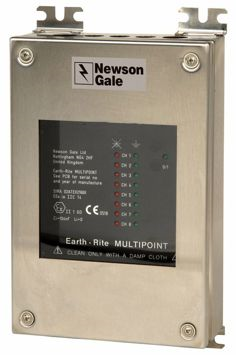Powder processing operations can generate vast quantities of electrostatic charge via the movement of powder. The standard method of charging on powder processing operations is due to tribo-electrification, which is basically the contact and separation of the powder with processing equipment, the powder itself or other factors that can cause charging, like surface contaminants. There are numerous types of equipment that can cause the charging of powders.
 Static Grounding protection in powder processing operations.
Static Grounding protection in powder processing operations.
In pharmaceutical operations, equipment like powder conveying systems, micronizers, blenders and sieve stacks all make up multiple component assemblies that can accumulate high levels of electrostatic charge should any of the components be isolated from a true earth ground. Connections made with items like bonding straps can provide an intentional bond between metal components or assembly mating surfaces may provide an inherent bonded connection.
Static grounding solutions: convention versus flexibility.
Most grounding solutions provide grounding protection for discrete pieces of equipment at risk of electrostatic charging like road tanker trucks, railcars, IBCs and drums. Powder processing equipment presents more of a challenge as there are many metal parts that can make up larger assemblies that are electrically isolated from each other. It is therefore important to ensure that multiple components that come into contact with charged powders do have a means of being monitored for static grounding protection purposes.
 A more specialised static grounding system, like the Earth-Rite® MULTIPOINT, provides the benefits of eight discrete static grounding systems rolled up into a single package. This gives installer’s the flexibility of providing monitored static grounding protection for multiple components of powder processing assemblies through a discrete wall mounted monitoring unit with eight ground status indicators for each component being monitored.
A more specialised static grounding system, like the Earth-Rite® MULTIPOINT, provides the benefits of eight discrete static grounding systems rolled up into a single package. This gives installer’s the flexibility of providing monitored static grounding protection for multiple components of powder processing assemblies through a discrete wall mounted monitoring unit with eight ground status indicators for each component being monitored.
If the Earth-Rite® MULTIPOINT’s monitoring unit detects that an assembly component is not grounded, it will send a signal to the controller which, if interlocked with the circuit powering the operation, can halt the process, thereby eliminating the electrostatic charging mechanism and potential charging of un-grounded equipment.
If such an event does occur, the plant’s technicians can rapidly identify which connection needs to be investigated. They can do this by referencing the monitoring unit’s ground status indicator panel which will indicate which channel needs to be checked. Once the connection to the equipment is re-established the Earth-Rite® MULTIPOINT controller will provide a permissive condition for the process to start again.
The most common set up, from an interlock option perspective, is to halt the entire process via a single relay output from the Earth-Rite® MULTIPOINT’s controller so that the isolated equipment can be identified and repaired. Halting the movement of the powder ensures that electrostatic charges are not being generated while a piece of plant equipment does not have grounding protection in place.
To read the full article, please click here to download FREE.

